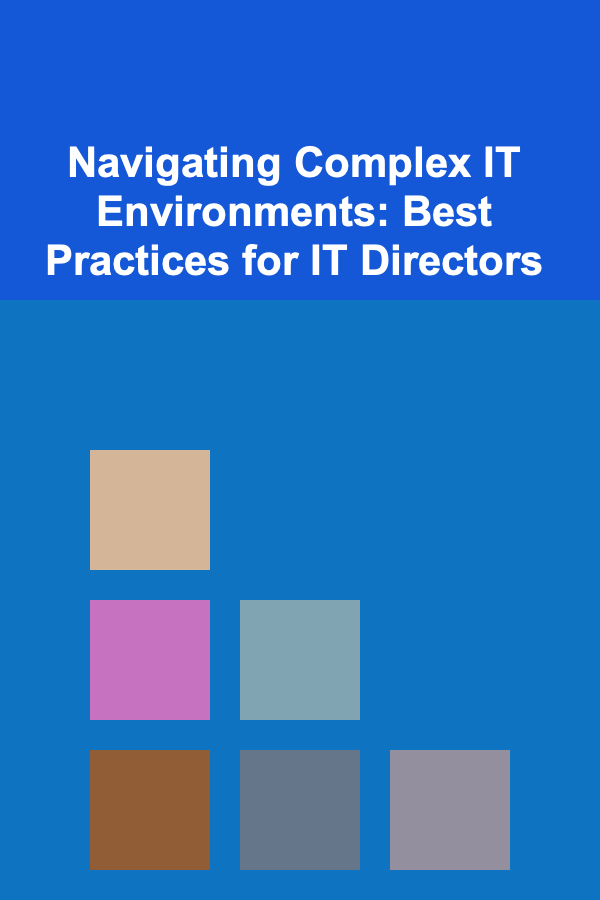
Navigating Complex IT Environments: Best Practices for IT Directors
ebook include PDF & Audio bundle (Micro Guide)
$12.99$9.99
Limited Time Offer! Order within the next:

In today's rapidly evolving technological landscape, IT Directors face the daunting task of managing increasingly complex IT environments. With the rise of cloud computing, the proliferation of data, the integration of diverse technologies, and the constant threat of cyberattacks, IT management has never been more challenging. As technology becomes more integral to business success, IT Directors must take proactive steps to navigate these complexities and ensure their organizations remain competitive, secure, and agile.
This guide explores actionable best practices for IT Directors to successfully manage complex IT environments, from strategic planning and effective resource management to risk mitigation and fostering a culture of innovation.
Embrace Strategic IT Planning
Align IT Strategy with Business Goals
The first step in navigating a complex IT environment is to ensure that IT initiatives are aligned with the organization's broader business goals. IT is no longer just a support function; it plays a critical role in driving business growth, innovation, and competitive advantage. To achieve this alignment, IT Directors should work closely with business leaders to understand the organization's objectives and priorities.
Best Practice:
- Collaborate with business units to identify strategic goals such as market expansion, product innovation, or customer experience improvement. Ensure IT projects directly contribute to achieving these goals.
- Establish measurable KPIs that track IT's contribution to business outcomes, such as cost savings, efficiency gains, or revenue growth.
Adopt a Holistic IT Roadmap
A clear IT roadmap is essential for navigating complex IT environments. This roadmap should outline both short-term and long-term goals, as well as the technological investments needed to meet these objectives. The roadmap should be flexible, allowing for adjustments in response to changing business needs, new technologies, and external challenges.
Best Practice:
- Build a dynamic IT roadmap that includes cloud migration plans, infrastructure upgrades, cybersecurity measures, and application development.
- Review and adjust the roadmap regularly to stay aligned with evolving business priorities and technological trends.
Implement Robust Governance and Risk Management Practices
Establish Strong IT Governance Frameworks
With growing complexity, it becomes critical to have a robust governance framework in place to manage IT resources, projects, and compliance. IT governance ensures that technology investments are effectively aligned with organizational objectives, and that projects are executed on time, within scope, and within budget.
Best Practice:
- Develop clear IT policies and procedures for decision-making, resource allocation, and performance measurement. Ensure transparency and accountability across all levels of the IT organization.
- Foster a culture of compliance by ensuring adherence to regulatory requirements, data privacy standards, and industry best practices.
Proactively Manage Risk
In a complex IT environment, risk management is more important than ever. Cybersecurity threats, system failures, and data breaches can cause significant damage to an organization. IT Directors must proactively identify potential risks and implement mitigation strategies to safeguard the organization's infrastructure, data, and intellectual property.
Best Practice:
- Conduct regular risk assessments to identify vulnerabilities in your IT environment. Use tools like penetration testing, vulnerability scanning, and threat modeling to assess the security of systems and applications.
- Create a comprehensive disaster recovery and business continuity plan to ensure the organization can quickly recover from disruptions.
Foster a Culture of Collaboration and Innovation
Encourage Cross-Functional Collaboration
In today's complex IT environments, no department operates in isolation. IT Directors must encourage collaboration between IT and other business units such as marketing, finance, operations, and customer service. By breaking down silos and fostering cross-functional communication, organizations can better understand the needs of various stakeholders and deliver technology solutions that truly meet business objectives.
Best Practice:
- Establish regular cross-functional meetings where IT and business leaders can collaborate, share insights, and align on priorities.
- Create collaborative working groups for specific projects to ensure all relevant perspectives are considered and that the project's scope remains aligned with organizational goals.
Promote a Culture of Innovation
As the business environment becomes more competitive, organizations must continuously innovate to stay ahead. IT Directors have a key role to play in fostering a culture of innovation by encouraging experimentation, adopting new technologies, and supporting creative problem-solving within IT teams.
Best Practice:
- Encourage experimentation with emerging technologies such as AI, blockchain, or IoT. Pilot small-scale projects to test their potential before full-scale implementation.
- Empower employees to propose innovative solutions and give them the tools and resources to turn ideas into reality. This includes investing in training programs, providing access to new tools, and fostering a growth mindset across the organization.
Optimize IT Resource Management
Invest in Scalable Infrastructure
As businesses grow and the IT environment becomes more complex, scalability becomes a critical factor in managing resources effectively. IT Directors must ensure that the infrastructure can scale to meet the organization's demands, whether that means scaling up on-premises systems or expanding cloud-based solutions.
Best Practice:
- Leverage cloud computing to provide flexibility and scalability. Cloud platforms like AWS, Azure, or Google Cloud can easily scale to meet fluctuating demand without the need for heavy upfront capital investments.
- Implement hybrid infrastructure models that combine on-premises data centers with cloud solutions to create a flexible, cost-effective, and scalable IT environment.
Maximize Resource Utilization
In complex IT environments, it's essential to optimize the use of available resources to minimize waste and maximize efficiency. IT Directors should implement strategies to ensure that hardware, software, and human resources are used effectively.
Best Practice:
- Implement automated resource management tools that allow IT teams to monitor system performance and allocate resources dynamically based on demand.
- Consolidate IT assets where possible. This includes using virtualization and containerization to maximize server utilization and reduce infrastructure costs.
Optimize IT Spend
Given the increasing complexity of IT environments, controlling costs while ensuring the effectiveness of IT investments is crucial. IT Directors must adopt cost-effective strategies for managing IT budgets and ensuring that every dollar spent delivers measurable value to the business.
Best Practice:
- Use cloud cost optimization tools to monitor and manage cloud expenditures. Tools like CloudHealth or CloudCheckr can help optimize cloud usage and reduce wasteful spending.
- Negotiate better contracts with vendors and explore cost-effective open-source alternatives where appropriate.
Ensure Continuous Monitoring and Improvement
Implement Real-Time Monitoring
Continuous monitoring of IT systems is critical in managing complex environments. IT Directors must implement real-time monitoring solutions to track the performance of infrastructure, applications, and security systems. This enables organizations to identify and resolve issues before they impact users or business operations.
Best Practice:
- Use integrated monitoring platforms like Nagios, Prometheus, or Splunk to track performance across systems, networks, and applications.
- Set up automated alerts for critical incidents, such as system downtimes, performance degradation, or security breaches, to ensure quick responses.
Embrace Continuous Improvement
To stay ahead of the curve, IT Directors must foster a mindset of continuous improvement within their teams. This involves regularly reviewing processes, measuring performance, and making incremental improvements to enhance efficiency, security, and user experience.
Best Practice:
- Implement a feedback loop where IT teams, business stakeholders, and end-users can provide input on the effectiveness of IT systems and processes.
- Adopt methodologies like Agile and DevOps to ensure that IT teams can quickly respond to changing business needs, deliver high-quality solutions, and continuously improve their practices.
Conclusion
Navigating a complex IT environment requires a multifaceted approach, combining strategic planning, robust governance, collaboration, and continuous improvement. As an IT Director, your role extends beyond simply managing technology---you are responsible for aligning IT with business objectives, ensuring the security and reliability of systems, and fostering a culture of innovation and collaboration across the organization.
By implementing these best practices, IT Directors can successfully steer their organizations through the complexities of modern IT environments, ensuring that technology continues to drive business success while mitigating risks and optimizing resources.

How to Capture Special Moments Beyond the Wedding Day
Read More
How to Grow a Lush Garden with These Thrifty Gardening Tips
Read More
How to Soundproof Your Home From Traffic and Street Noise
Read More
How to Start a Passive Income Business with Deep Learning
Read More
How to Build a Stronger Chest and Arms
Read More
How to Facilitate Agile Retrospectives That Actually Work
Read MoreOther Products

How to Capture Special Moments Beyond the Wedding Day
Read More
How to Grow a Lush Garden with These Thrifty Gardening Tips
Read More
How to Soundproof Your Home From Traffic and Street Noise
Read More
How to Start a Passive Income Business with Deep Learning
Read More
How to Build a Stronger Chest and Arms
Read More